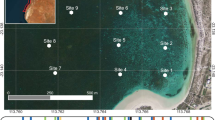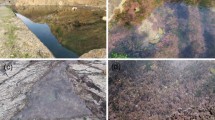Abstract
We investigated the effect of different levels of hypercapnia-induced acidification (pH = 7.96, 7.31, 6.74 and 6.05) on the extracellular acid base balance of a shallow-water crustacean, the velvet swimming crab Necora puber over a period of 16 days. Any extracellular acidosis incurred was completely compensated by an increase in bicarbonate. Bicarbonate was partly, but not wholly, supplied by dissolution of the exoskeleton. This compensation was sustained for 16 days under all experimental treatments with two exceptions. First there was some evidence of extracellular acidosis in crabs after 16 days at pH = 6.74. Second at the lowest environmental pH (6.05) there was a marked uncompensated acidosis after 24 h. Necora puber appears less sensitive to low pH than many other species examined acutely. However, local acidification as a result of ocean CO2 dispersal or leakage from geological sequestration is likely to compromise even this species.



Similar content being viewed by others
References
Burnett LE (1997) The challenges of living in hypoxic and hypercapnic aquatic environments. Am Zool 37:633–640
Caldeira K, Wickett ME (2003) Anthropogenic carbon and ocean pH. Nature 425:365
Cameron JN (1978) Effect of hypercapnia on blood acid–base status, NaCl fluxes, and trans-gill potential in freshwater blue crabs Callinectes sapidus. J Comp Physiol 123:137–141
Cameron JN (1985) Compensation of hypercapnic acidosis in the aquatic blue crab, Callinectes sapidus: the predominance of external sea water over carapace carbonate as the protein sink. J Exp Biol 114:197–206
Cameron JN (1986) Acid–base equilibria in invertebrates. In: Heisler N (eds) Acid-base regulation in animals. Elsevier, New York, pp 357–394
Cameron JN (1989) Acid–base homeostasis: past and present perspectives. Physiol Zool 62:845–865
Cameron JN, Iwama GK (1987) Compensation of progressive hypercapnia in channel catfish and blue crabs. J Exp Biol 57:673–680
Cameron JN, Iwama GK (1989) Compromises between ionic regulation and acid–base regulation in aquatic animals. Can J Zool 67:3078–3084
Cameron JN, Mangum CP (1983) Environmental adaptations of the respiratory system: ventilation, circulation and oxygen transport. In: Bliss DE (ed) Biology of Crustacea, Vol 8. Academic, New York
Carman KR, Thistle D, Fleeger JW, Barry JP (2004) Influence of introduced CO2 on deep-sea metazoan meiofauna. J Oceanogr 60:767–772
Childress JJ, Lee R, Sanders NK, Felbeck H, Oros A, Toulmond A, Desbruyeres CK, Brooks J (1993) Inorganic carbon uptake in hydrothermal vent tubeworms facilitated by high environmental \( P_{{{\text{CO}}_{{\text{2}}} }} \). Nature 362:147–149
Clairborne JB, Evans DE (1992) Acid–base balance and ion transfers in the spiny dogfish (Squalus acanthias) during hypercapnia. A role for ammonia excretion. J Exp Zool 261:9–17
Clairborne J, Edwards S, Morrison-Shetlar A (2002) Acid–base regulation in fishes: cellular and molecular mechanisms. J Exp Zool 293:302–319
deFur PL, Wilkes PRH, McMahon BR (1980) Non-equilibrium acid–base status in C. productus: role of exoskeletal carbonate buffers. Respir Physiol 42:247–261
Halmann MM, Steinberg M (1999) Greenhouse gas carbon dioxide mitigation: science and technology. Lewis publishers, Washington
Hawkins DG (2004) No exit: thinking about leakage from geologic carbon storage sites. Energy 29:1571–1578
Hayashi M, Kita J, Ishimatsu A (2004) Acid–base responses to lethal aquatic hypercapnia in three marine fishes. Mar Biol Berl 144:153–160
Heisler N (1984) Acid–base regulation in fishes. In: Hoar WS, Randall DJ (eds) Fish physiology, vol XA. Academic, New York, pp 315–401
Heisler N (1989) Parameters and methods in acid–base physiology. In: Bridges CR, Butler PJ (eds) Techniques in comparative respiratory physiology. Cambridge University Press, Cambridge, pp 305–332
Heisler N (1993) Acid–base regulation. In: Evans DH (ed) The physiology of fishes. CRC, Boca Raton, pp 343–377
Henry RP, Kormanik GA, Smatresk NJ, Cameron JN (1981) The role of shell dissolution as a source of HCO3 for buffering hypercapnic acidosis in aquatic and terrestrial decapod crustaceans. J Exp Biol 94:269–274
Holloway S (2005) Underground sequestration of carbon dioxide—a viable greenhouse gas mitigation option. Energy 30:2318–2333
Kerr RA (2001) Bush backs spending for a ‘global problem’. Science 292:1978
Kita J, Ohsumi T (2004) Perspectives on biological research for CO2 ocean sequestration. J Oceanogr 60:695–703
Kleypas JA et al (1999) Geochemical consequences of increased atmospheric carbon dioxide on coral reefs. Science 284:118–120
Knoll AK, Bambach RK, Canfield DE, Grotzinger JP (1996) Comparative earth history and late Permian mass extinction. Science 273:452–457
Kurihara H, Shimode S, Shirayama Y (2004) Sub-lethal effects of elevated concentrations of CO2 on planktonic copepods and sea urchins. J Oceanogr 60:743–750
Langenbuch M, Pörtner HO (2002) Changes in metabolic rate and N excretion in the marine invertebrate Sipunculus nudus under conditions of environmental hypercapnia: identifying effective acid–base variables. J Exp Biol 205:1153–1160
Larsson BK, Pörtner HO, Jensen FB (1997) Extra- and intracellular acid–base balance and ionic regulation in cod (Gadus morhua) during combined and isolated exposure to hypercapnia and copper. Mar Biol Berl 128:337–346
Lindinger MI, Lauren DJ, McDonald DG (1984) Acid–base balance in the sea mussel, Mytilus edulis III. Effects of environmental hypercapnia on intra- and extracellular acid–base balance. Mar Biol Lett 5:371–381
Marchetti C (1977) On geoengineering and the CO2 problem. Climate Change 1:59–68
Michaelidis B, Ouzounis C, Paleras A, Pörtner HO (2005) Effects of long-term moderate hypercapnia on acid–base balance and growth rate in marine mussels Mytilus galloprovincialis. Mar Ecol Prog Ser 293:109–118
Miles H, Widdicombe S, Spicer JI, Hall-Spencer J (2006) Effects of anthropogenic ocean acidification and CO2 sequestration on acid–base balance in intertidal sea urchins Psammechinus miliaris. Mar Poll Bull. DOI 10.1016/j.marpolbul.2006.09.021 (in press)
Morritt D, Spicer JI (1993) A brief re-examination of the function and regulation of extracellular magnesium and its relationship to activity in crustacean arthropods. Comp Biochem Physiol 106A:19–23
Orr JC, Fabry VJ, Aumont O et al (2005) Anthropogenic ocean acidification over the twenty-first century and its impact on calcifying organisms. Nature 437:681–686
Pörtner HO, Reipschläger A, Heisler N (1998) Acid–base regulation, metabolism and energetics in Sipunculus nudus as a function of ambient carbon dioxide level. J Exp Biol 201:43–54
Pörtner HO, Bock C, Reipschläger A (2000) Modulation of the cost of pHi regulation during metabolic depression: a 31PNMR study in invertebrate (Sipunculus nudus) isolated muscle. J Exp Biol 203:2417–2428
Pörtner HO, Langenbuch M, Reipschläger A (2004) Biological impact of elevated ocean CO2 concentrations: lessons from animal physiology and Earth history. J Oceanogr 60:705–718
Raven J, Caldeira K, Elderfield H, Hoegh-Guldberg O, Liss P, Riebesell U, Shepherd J, Turley C, Watson A (2005) Ocean acidification due to increasing atmospheric carbon dioxide. The Royal Society policy document 12/05. The Cloyvedon Press, Cardiff
Riebesell U et al (2000) Reduced calcification of marine plankton in response to increased atmospheric CO2. Nature 407:364–367
Seibel BA, Walsh PJ (2003) Biological impacts of deep-sea carbon-dioxide injection inferred from indices of physiological performance. J Exp Biol 206:641–650
Spicer JI (1995) Respiratory consequences of exposure to declining oxygen tension in the sea urchin Psammechinus miliaris Gmelin. Mar Biol Berl 124:71–76
Spicer JI, Taylor AC, Hill AD (1988) Acid–base status in the sea urchins Psammechinus miliaris and Echinus esculentus (Echinodermata: Echinoidea) during emersion. Mar Biol Berl 99:527–534
Taylor AC, Spicer JI (1991) Acid base disturbances in the haemolymph of the prawns, Palaemon elegans (Rathke) and P. serratus (Pennant) (Crustacea: Decapoda) during exposure to hypoxia. Comp Biochem Physiol 98A:445–452
Thistle D, Carman KR, Sedlacek L, Brewer PG, Fleeger JW, Barry JP (2005) Deep-ocean, sediment-dwelling animals are sensitive to sequestered carbon dioxide. Mar Ecol Prog Ser 289:1–4
Toews DP, Holeton GF, Heisler N (1983) Regulation of acid–base status during environmental hypercapnia in the marine teleost fish Conger conger. J Exp Biol 107:9–20
Truchot JP (1975) Action de l’hypercapnie sur l’etat acide-base du sang chez le crabe Carcinus maenas (L.) (Crustacé, Décapode). C R Acad Sci Paris 280:311–314
Truchot JP (1976a) Carbon dioxide combining properties of the blood of the shore crab Carcinus maenas (L): carbon dioxide solubility coefficient and carbonic acid dissociation constants. J Exp Biol 64:45–57
Truchot JP (1976b) Carbon dioxide combining properties of the blood of the shore crab, Carcinus maenas (L): CO2-dissociation curves and Haldane effect. J Comp Physiol 112:283–293
Truchot JP (1979) Mechanisms of compensation of blood respiratory acid–base disturbances in the shore crab Carcinus maenas (L). J Exp Zool 210:407–416
Truchot JP (1983) Regulation of acid–base balance. In: Bliss DE (ed) The biology of Crustacea, Volume 5. Academic, New York
Truchot JP (1987) Comparative aspects of extracellular acid–base balance. Springer, Berlin Heidelberg New York
Truchot JP, Duhamel-Jouve A (1980) Oxygen and carbon dioxide in the marine intertidal environment: diurnal and tidal changes in rock pools. Respir Physiol 39:241–254
Truchot JP, Forgue J (1998) Effect of water alkalinity on gill CO2 exchange and internal Pco2 in aquatic animals. Comp Biochem Physiol 119A:131–136
Watt AJS, Whiteley NM, Taylor EW (1999) An in situ study of respiratory variables in three British sublittoral crabs with different routine rates of activity. J Exp Mar Biol Ecol 239:1–21
Wheatly MG, Henry RP (1992) Extracellular and intracellular acid–base regulation in crustaceans. J Exp Zool 263:127–142
Acknowledgments
We thank Julie Soanes, Anne Torr, Roger Haslam, Hazel Needham, Malcolm Liddicoat, Hayley Miles, Chris Gallienne and Charlie Ward for their technical assistance. This study was part-funded by a joint DEFRA/DTI funded project IMCO2 (http://www.dti.gov.uk/energy/coal/cfft/cct/pub) and the NERC standard grant (NE/C510016/1) awarded to SW. We thank Angus Atkinson and three anonymous referees for their helpful comments.
Author information
Authors and Affiliations
Corresponding author
Additional information
Communicated by A. Atkinson, Cambridge.
Rights and permissions
About this article
Cite this article
Spicer, J.I., Raffo, A. & Widdicombe, S. Influence of CO2-related seawater acidification on extracellular acid–base balance in the velvet swimming crab Necora puber . Mar Biol 151, 1117–1125 (2007). https://doi.org/10.1007/s00227-006-0551-6
Received:
Accepted:
Published:
Issue Date:
DOI: https://doi.org/10.1007/s00227-006-0551-6




